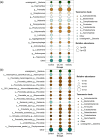Oral microbiota signatures in obesity with or without acanthosis nigricans in a Chinese cohort
- PMID: 40465467
- PMCID: PMC12137914
- DOI: 10.1099/jmm.0.002020
Oral microbiota signatures in obesity with or without acanthosis nigricans in a Chinese cohort
Abstract
Introduction. The oral microbiota is the second most complex microbial community in the human body. It has been suggested that poor oral health may be associated with an increased risk of obesity.Hypothesis/Gap Statement. However, both previous observational and mechanistic studies on oral microbiota do not take into account the obesity-related acanthosis nigricans (AN), which is the most common dermatological manifestation in individuals with obesity.Aim. This study aimed to investigate the altered composition, function and diagnostic value of the oral microbiota in obesity with or without acanthosis nigricans (AN).Methodology. We characterized the oral bacteria signature in a Chinese cohort (ChiCTR2300073353) of 99 patients with obesity and obesity-related AN (Ob_AN) and 50 healthy controls using 16S rRNA gene V3-V4 region sequencing.Results. The microbial richness (abundance-based coverage estimators and observed species indices) was significantly greater in the Ob_AN and obesity groups than in the control group; however, microbial diversity (Shannon index) did not differ significantly. Distinct separation in the microbial community amongst the three groups was observed. Prevotella species, including Prevotella melaninogenica, Prevotella nanceiensis and Prevotella pallens, were associated with composition alterations and predicted functions (significant downregulation of ATP-binding cassette transporters) associated with microbial dysbiosis in the obesity and Ob_AN groups. Moreover, Prevotella and Lautropia genera assessments could indicate obesity and obesity-related AN risk.Conclusions. The notable reduction of plenty of oral microbiota and high levels of Prevotella spp. may play a critical role in obesity with AN. Oral microbiota may serve as biomarkers for diagnosing, preventing and even treating obesity-related AN.
Keywords: Prevotella; acanthosis nigricans; bacteria; obesity; oral microbiota.
Conflict of interest statement
The authors declare that there are no conflicts of interest.
Figures







Similar articles
-
Insights into the blood, gut, and oral microbiomes in Chinese patients with myocardial infarction: a case-control study.BMC Microbiol. 2025 Apr 19;25(1):226. doi: 10.1186/s12866-025-03878-9. BMC Microbiol. 2025. PMID: 40253360 Free PMC article.
-
The human oral cavity microbiota composition during acute tonsillitis: a cross-sectional survey.BMC Oral Health. 2019 Dec 5;19(1):275. doi: 10.1186/s12903-019-0956-5. BMC Oral Health. 2019. PMID: 31806002 Free PMC article.
-
Comparative analysis of the human microbiome from four different regions of China and machine learning-based geographical inference.mSphere. 2025 Jan 28;10(1):e0067224. doi: 10.1128/msphere.00672-24. Epub 2024 Dec 19. mSphere. 2025. PMID: 39699186 Free PMC article.
-
Oral microbiota distinguishes patients with osteosarcoma from healthy controls.Front Cell Infect Microbiol. 2024 Jul 11;14:1383878. doi: 10.3389/fcimb.2024.1383878. eCollection 2024. Front Cell Infect Microbiol. 2024. PMID: 39055977 Free PMC article.
-
The oral microbiome and human health.J Oral Sci. 2017;59(2):201-206. doi: 10.2334/josnusd.16-0856. J Oral Sci. 2017. PMID: 28637979 Review.
References
MeSH terms
Substances
Supplementary concepts
LinkOut - more resources
Full Text Sources
Medical
Miscellaneous

